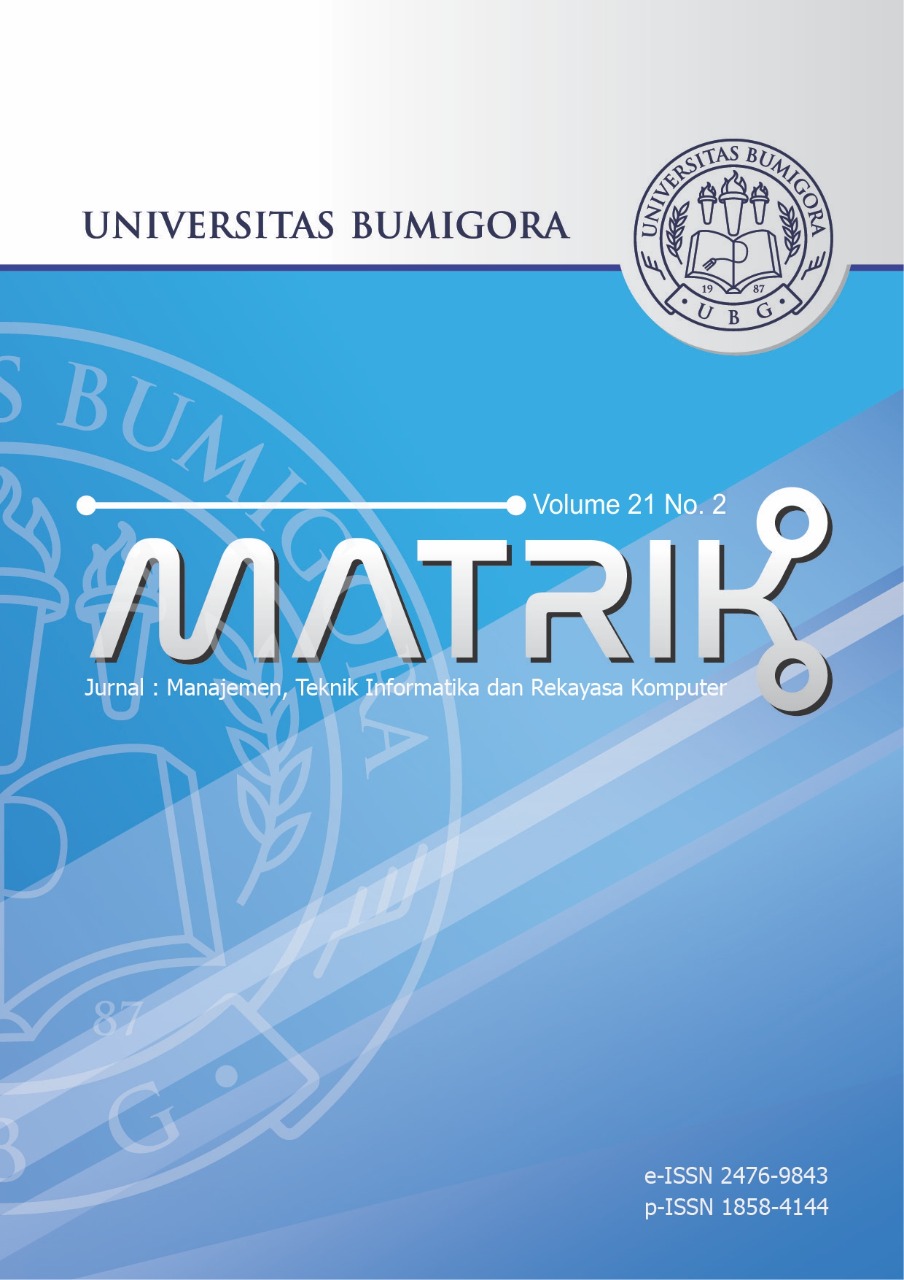Implementation of K-Means Clustering on Poverty Indicators in Indonesia
DOI:
https://doi.org/10.30812/matrik.v21i2.1289Keywords:
Poverty Gap Index, Poverty Severity Index, K-Means, Machine Learning, Cluster AnalysisAbstract
This study aims to cluster all districts/cities in Indonesia related to poverty indicators. The attributes used are poverty gap index and poverty severity index. The data used comes from BPS. The method used is K-Means clustering, and the results show that by using the elbow and silhouette index methods, the optimal number of clusters is 2, where for cluster 1, it can be defined as a cluster with an area with a high poverty gap index and poverty severity index compared to cluster 2. As a result, cluster 1 has 42 districts/cities, and 472 for cluster 2.
Downloads
References
[2] B. Poerwanto, R. Y. Fa’rifah, W. Sanusi, and S. Side, “A matlab code to compute prediction of survival trends in patients with DHF,†Journal of Physics: Conference Series, vol. 1028, no. 1, pp. 1–7, Jun. 2018.
[3] M. Barchitta et al., “Cluster analysis identifies patients at risk of catheter-associated urinary tract infections in intensive care units: findings from the SPIN-UTI Network,†Journal of Hospital Infection, vol. 107, pp. 57–63, Jan. 2021.
[4] Y. Meng, J. Liang, F. Cao, and Y. He, “A new distance with derivative information for functional k-means clustering algorithm,†Information Sciences, vol. 463–464, pp. 166–185, Oct. 2018.
[5] S. Askari, “Fuzzy C-Means clustering algorithm for data with unequal cluster sizes and contaminated with noise and outliers: Review and development,†in Expert Systems with Applications, Mar. 2021, vol. 165, pp. 1–71.
[6] B. Poerwanto and R. Y. Fa’rifah, “Analisis Cluster K-Means dalam Pengelompokan Kemampuan Mahasiswa,†Indonesian Journal of Fundamental Sciences, vol. 2, no. 2, pp. 92–96, 2016.
[7] J. Heil, V. Häring, B. Marschner, and B. Stumpe, “Advantages of fuzzy k-means over k-means clustering in the classification of diffuse reflectance soil spectra: A case study with West African soils,†Geoderma, vol. 337, pp. 11–21, Mar. 2019.
[8] V. Heidrich-Meisner and R. F. Wimmer-Schweingruber, Solar wind classification via k-means clustering algorithm. Elsevier Inc., 2018.
[9] B. Poerwanto, “Evaluating the K-Means Analysis in Clustering Area Based on Estates Productivity in Tana Luwu Using Silhouette Index,†Journal of Physics: Conference Series, vol. 1752, no. 1, pp. 1–7, Feb. 2021.
[10] M. Moatsos and A. Lazopoulos, “Global poverty: A first estimation of its uncertainty,†World Development Perspectives, vol. 22, pp. 1–16, Jun. 2021.
[11] BPS, Berita Resmi Statistik. Jakarta: Badan Pusat Statistika, 2020.
[12] A. T. Rahman, Wiranto, and A. Rini, “Coal Trade Data Clustering Using K-Means (Case Study Pt. Global Bangkit Utama),†ITSMART: Jurnal Teknologi dan Informasi, vol. 6, no. 1, pp. 24–31, 2017.
[13] Y. Hozumi, R. Wang, C. Yin, and G.-W. Wei, “UMAP-assisted K-means clustering of large-scale SARS-CoV-2 mutation datasets,†Computers in Biology and Medicine, vol. 131, pp. 1–14, Apr. 2021.
[14] M. A. Nahdliyah, T. Widiharih, and A. Prahutama, “Metode K-Medoids Clustering dengan Validasi Silhouette Index dan C-Index,†Jurnal Gaussian, vol. 8, no. 2, pp. 161–170, 2019.
[15] N. Chalid and Y. Yusuf, “Pengaruh Tingkat Kemiskinan dan Tingkat Pengangguran, Upah Minimun Kabupaten/Kota Dan Laju Pertumbuhan Ekonomi Terhadap Indeks Pembangunan Manusia di Provinsi Riau,†Jurnal Ekonomi, vol. 22, no. 2, pp. 1–12, 2014.
[16] A. Artino, B. Juanda, and S. Mulatsih, “The Relationship of Village Funds to Poverty,†Tataloka, vol. 21, no. 3, pp. 381–389, 2019.
Downloads
Published
Issue
Section
How to Cite
Similar Articles
- Nurahman Nurahman, Agung Purwanto, Sigit Mulyanto, Klasterisasi Sekolah Menggunakan Algoritma K-Means berdasarkan Fasilitas, Pendidik, dan Tenaga Pendidik , MATRIK : Jurnal Manajemen, Teknik Informatika dan Rekayasa Komputer: Vol. 21 No. 2 (2022)
- Muhammad Rizki, Arief Hermawan, Donny Avianto, Learning Accuracy with Particle Swarm Optimization for Music Genre Classification Using Recurrent Neural Networks , MATRIK : Jurnal Manajemen, Teknik Informatika dan Rekayasa Komputer: Vol. 23 No. 2 (2024)
- Virdiana Sriviana Fatmawaty, Imam Riadi, Herman Herman, Higher Education Institution Clustering Based on Key Performance Indicators using Quartile Binning Method , MATRIK : Jurnal Manajemen, Teknik Informatika dan Rekayasa Komputer: Vol. 24 No. 1 (2024)
- Annisa Nurul Puteri, Suryadi Syamsu, Topan Leoni Putra, Andita Dani Achmad, Support Vector Machine for Predicting Candlestick Chart Movement on Foreign Exchange , MATRIK : Jurnal Manajemen, Teknik Informatika dan Rekayasa Komputer: Vol. 22 No. 2 (2023)
- Yuniansyah Yuniansyah, Andri Saputra, PENGEMBANGAN MULTIMEDIA PEMBELAJARAN UNTUK MATAKULIAH GRAFIK KOMPUTER MENGGUNAKAN METODE ADDIE , MATRIK : Jurnal Manajemen, Teknik Informatika dan Rekayasa Komputer: Vol. 17 No. 1 (2017)
- Hadi Santoso, Hilyah Magdalena, Helna Wardhana, Aplikasi Dynamic Cluster pada K-Means BerbasisWeb untuk Klasifikasi Data Industri Rumahan , MATRIK : Jurnal Manajemen, Teknik Informatika dan Rekayasa Komputer: Vol. 21 No. 3 (2022)
- Edi Ismanto, Januar Al Amien, Vitriani Vitriani, A Comparison of Enhanced Ensemble Learning Techniques for Internet of Things Network Attack Detection , MATRIK : Jurnal Manajemen, Teknik Informatika dan Rekayasa Komputer: Vol. 23 No. 3 (2024)
- Reo Wicaksono, Didik Dwi Prasetya, Ilham Ari Elbaith Zaeni, Nadindra Dwi Ariyanta, Tsukasa Hirashima, Machine Learning for Open-ended Concept Map Proposition Assessment: Impact of Length on Accuracy , MATRIK : Jurnal Manajemen, Teknik Informatika dan Rekayasa Komputer: Vol. 25 No. 1 (2025)
- Mamluatul Hani'ah, Moch Zawaruddin Abdullah, Wilda Imama Sabilla, Syafaat Akbar, Dikky Rahmad Shafara, Google Trends and Technical Indicator based Machine Learning for Stock Market Prediction , MATRIK : Jurnal Manajemen, Teknik Informatika dan Rekayasa Komputer: Vol. 22 No. 2 (2023)
- Pardomuan Robinson Sihombing, Istiqomatul Fajriyah Yuliati, Penerapan Metode Machine Learning dalam Klasifikasi Risiko Kejadian Berat Badan Lahir Rendah di Indonesia , MATRIK : Jurnal Manajemen, Teknik Informatika dan Rekayasa Komputer: Vol. 20 No. 2 (2021)
You may also start an advanced similarity search for this article.
Most read articles by the same author(s)
- Bobby Poerwanto, Fajriani Fajriani, Resilient Backpropagation Neural Network on Prediction of Poverty Levels in South Sulawesi , MATRIK : Jurnal Manajemen, Teknik Informatika dan Rekayasa Komputer: Vol. 20 No. 1 (2020)
- Bobby Poerwanto, Baso Ali, Implementasi Algoritma Fuzzy C-Means dalam Mengelompokkan Kecamatan di Tana Luwu Berdasarkan Produktifitas Hasil Perkebunan , MATRIK : Jurnal Manajemen, Teknik Informatika dan Rekayasa Komputer: Vol. 19 No. 1 (2019)


.png)












